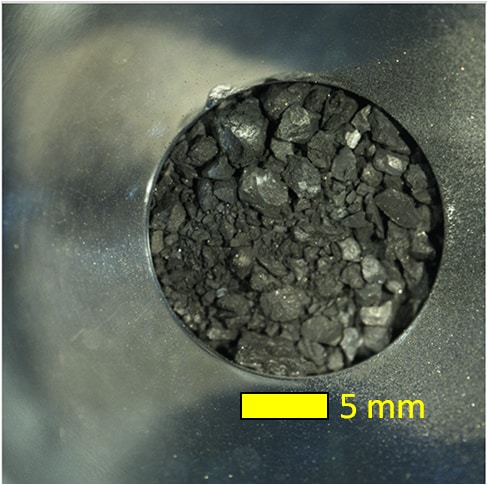The first analysis of samples from the asteroid Ryugu returned to Earth by the Japan Aerospace Exploration Agency’s Hayabusa2 spacecraft offers new insights into Ryugu’s formation history.
Laboratory analysis of 17 individual grains from the samples collected by Hayabusa2 found CO2-bearing water in an iron-nickel sulfide crystal, indicating the parent body formed in the outer Solar System, says the paper “Formation and evolution of carbonaceous asteroid Ryugu: Direct evidence from returned samples” that appears in Science. Planetary Science Institute Senior Scientists Deborah Domingue, Faith Vilas and Amanda Hendrix are co-authors on the paper, and Tomoki Nakamura of Tohoku University, Japan is the lead author.
“The Hayabusa2 spacecraft sampled the surface twice: once on Feb. 21, 2019, and again on July 11, 2019. The first sampled the undisturbed surface, the second sampled the regolith excavated by the artificial impact created earlier during the mission. This study examined grains from both sample sites, providing samples that can really provide insight into Ryugu’s evolution,” Domingue said. In addition, finer-grained powder samples less than 1 millimeter in size from both sample collection chambers were examined using reflectance spectroscopy techniques.
“The goal of these initial studies is to understand and characterize Ryugu’s formation history. While the orbital data identified the presence of phyllosilicates, it was analysis of the samples that gave us information on the detailed mineral composition and the physical properties of the regolith grains,” Domingue said. The article discusses that numerical simulations based on these results show us that Ryugu’s parent body formed approximately 2 million years after the birth of our Solar System, in the outer Solar System.
The mineralogy and petrology of the samples indicate the parent body formed in the region of the early Solar System where water and carbon dioxide existed as solids, farther than 3 to 4 times the distance from the Sun to Earth, possibly even beyond the orbit of Jupiter. This was followed by scattering inward to the main asteroid belt, to the current orbital position of the Polana and Eulalia asteroid families, which are about 2.5 times the distance from the Sun to Earth, The Polana and Eulalia asteroid families are the potential parent families of Ryugu based on orbital dynamical calculations of Ryugu’s origin.
Ryugu’s parent body was broken apart by a large-scale impact which formed either the Eulalia or Polana asteroid families, including Ryugu, which later migrated inward to its current orbit. Using the physical properties measured from the samples, models of the collision show that Ryugu formed from materials far from the impact site. The lack of shock features in the mineralogy, and the temperature consistent with the interlayer water found in Ryugu saponite (a clay mineral) are consistent with Ryugu’s formation from fragments excavated from areas far from the impact site. Ryugu’s composition – mineralogical and chemical – indicate Ryugu formed from fragments from multiple depths within its parent body.
“Studying the Ryugu samples in the lab provides a fantastic complement to other meteorite studies, because it allows us to learn about this specific known asteroidal object. For most meteorites, the precise parent body is unknown,” Hendrix said. “That allows us to then connect the dots and understand better the formation of the rubble pile, near-Earth asteroid Ryugu.”
“The mineralogy of the Ryugu samples is shown in this article to be highly similar to CI chondrites, a carbon-rich meteorite collected here on Earth. Understanding the formation history of Ryugu has real implications for understanding the origin of these meteorites and where their parent bodies formed in our Solar System,” Domingue said.
The spectral reflectance studies of the samples compared with similar measurements of meteorites, helped establish the connection between Ryugu and CI meteorites. These measurements also provided the connection between the sample mineralogy and the remote sensing observations acquired by the camera and spectrometer onboard the Hayabusa2 spacecraft.
“The visible observations by the camera system shows the first touchdown site is brighter than the second samples site, and this difference in visible reflectance is also seen between the samples acquired from each site,” Vilas said. Hayabusa2’s Near Infrared Spectrometer (NIRS3) observations show differences with the sample measurements in overall reflectance (the NIRS3 data are darker) and the depth of the clay absorption feature (the NIRS3 spectra display a shallower feature). “This difference is attributed, in part, to the particle size range and porosity differences between the surface and the samples, providing important information on the role of dust in the spectral properties of asteroid regoliths,” Vilas said.
The PSI scientists’ work on the paper was funded by a grant to PSI from NASA’s TREX Solar System Exploration Research Virtual Institute.
Visit https://global.jaxa.jp/press/2022/09/20220923-1_e.html to see JAXA’s press release on the paper.
Media Contact
Alan Fischer
Public Information Officer
520-382-0411
[email protected]
Science Contact
Deborah Domingue
Senior Scientist
[email protected]

